Why on earth would anyone want to wash their hair with baking soda?
Well, for one thing, using baking soda (sodium bicarbonate) on your hair is considered by some to be the oppositeof washing it (stay with me here). For those who prefer to avoid the unnecessary expense, natural oil-stripping chemicals, and unbelievable amounts of (likely) toxic fragrance involved with most store-bought shampoos, baking soda shampoo, also known as ‘poo-free or “no-poo” shampoo is the ideal solution. Some of the biggest unwanted elements you can avoid with ‘poo-free shampoo include DEA/Diethanolamine, sodium laurel sullfate, parabens, artificial color, scents, and dyes. In addition, baking soda shampoo helps prevent and treat dandruff when used regularly and doesn’t create build-up or residue.
But will it get my hair clean?
Yes and no. It will clarify your scalp, which is the root of the oils in your hair, and once this step is completed your hair is essentially clean. However, some sources indicate that repeated use of store-bought chemical-laden hair-stripping products may cause our hair to produce extra excess oil once we stop the habit. (Conversely, some find the opposite effect to be true in that they have drier hair than before stopping the chemical shampoos.) Both of these effects should only last temporarily, however, as your hair grows accustomed to the new situation, so don’t fret. Once your body adjusts to the missing chemical shampoo, it will stop making the excess oil (or dryness) and your hair will be naturally gorgeous in a way that might surprise you! On top of this, you may find you do not need to wash your hair as often as well, making just a few times per week sufficient for most people.
If you’d like to give it a try, grab a spoon, your baking soda (fresh preferred) and a glass of water. You will want to adjust the recipe as needed for your hair type and personal preferences, but for most people, an average tablespoon of baking soda mixed into one cup of water is perfect. Thicker, curlier, or more coarse hair may need a little more sodaand the very thin hair types may need less. *Please note: It’s important to remember to prepare your baking soda shampoo right before you plan to use it. Making it too far ahead of time can cause it to clump up.
Once it’s mixed up, pour it into a plastic bottle with a thin-tipped nozzle (a condiment bottle salvaged from the recycling bin might be just right). Then add a little more water once you’re in the shower ready to use it, and give it a good shake to mix again if it’s resettled. Some skip the first step and mix it directly in the bottle to save time, which is fine as long as you get the basic measurements right.
Then get your hair completely wet from scalp to tips and apply the mixture all over your scalp. Massage it in thoroughly and gently, then rinse out thoroughly. Once this is complete, your hair has been naturally cleansed. You won’t need to spend much time at all, if any, on the length of your hair as your primary area of concern is the scalp which produces the oil.
Some keep it even simpler and make a baking soda paste with one part baking soda to three or four parts water. This is scrubbed into the hair and scalp and allowed to sit for up to minutes, then thoroughly rinsed.
At this point, many no-‘poo method lovers do essentially the same thing with apple cider vinegar (one tablespoon vinegar to one cup water ratios) to balance out the baking soda and act as a natural “conditioner.” Some prefer to use lemon juice instead, which is equally acidic and causes the same results as the ACV. If you’re looking to add moisture to dry hair, you can also try using aloe or honey in place of the ACV step for a conditioner.
After some time has passed with using the baking soda shampoo/apple cider vinegar conditioner routine, some claim to be able to wash their hair less and less, sustaining the clean feeling longer and using just water between washings.
Caution: Please use caution to avoid getting the baking soda and/or apple cider vinegar into your eyes. This is especially important if you use the products on children, as these are not “no-tears” recipes. For active children, you may want to try a shampoo visor to help prevent contact getting the shampoo into the eyes.

